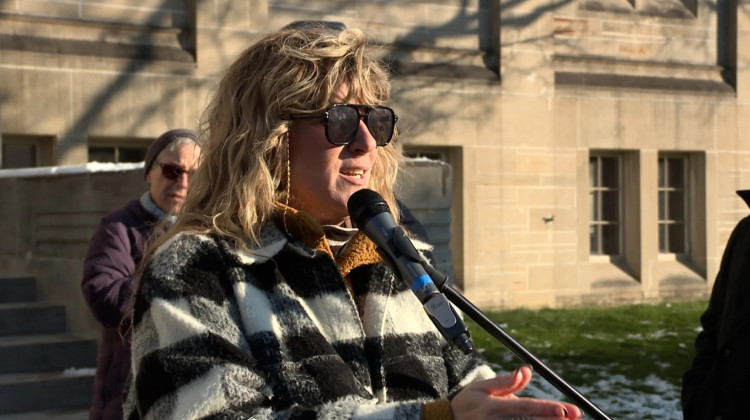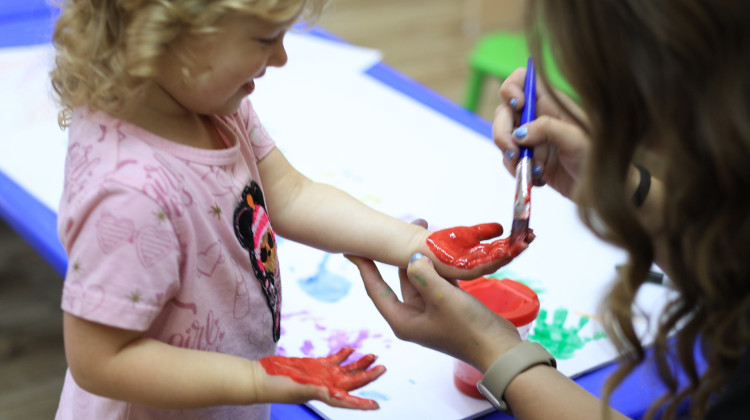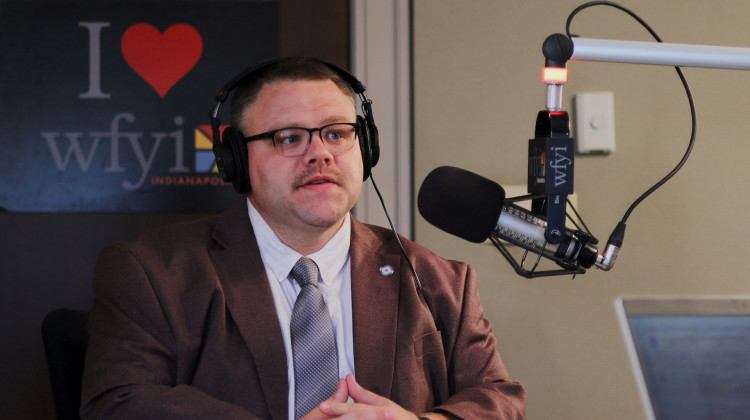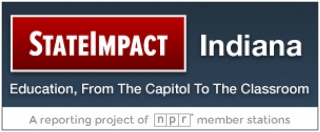
Cruz Tapia joins in a discussion among members of the United Northwest club about a documentary video on diversity during an after-school meeting at Northwest High School in Indianapolis. To his right is Maria Ulloa-Loza. Claudia Montes (left) is the college and career readiness adviser for English learners. Photo by Kelly Wilkinson/The Indianapolis Star
Schools focus on English learners but often overlook the lack of cultural understanding of their U.S.-born classmates
During his first week of school in the United States, fifth-grader Cruz Tapia climbed to the top of the slide on the playground.
Just being in school was part of the promise that America represented to his Mexican family. Like so many others, his family moved here to chase a vision of a better life, free of fear and filled with boundless opportunities.
In America, Tapia wouldn’t have to pass gangs with guns on every street corner. In America, he and his sister could attend school, instead of one having to work to afford the other’s education.
But when he went down the slide that day at recess, what awaited him at the bottom was a reminder that America, too, can have its own set of hostilities and challenges for immigrants. What awaited him also made him think his family wouldn’t last long here.
Three of his classmates shoved him to the ground. “Go back to your country,” they told him. “You don’t belong here.”
Tapia couldn’t speak English, couldn’t read it, couldn’t understand it — like thousands of other immigrant children who have come to Indianapolis from around the world over the past two decades.
He felt as though teachers didn’t want to teach him. He sat in front of a computer trying to learn English every morning until lunch, went to gym class and then returned to the same classroom to sit in front of the computer again.
Lost in school, he asked other Mexican students for help in Spanish. They ignored him.
“What makes them belong here?” he wondered to himself. “And what makes me not belong here?”
Schools pour resources into programs for English language learners. They hand out backpacks filled with school supplies. They train teachers to better instruct non-native speakers. They hire interpreters.
But experts say something else — something that might ease the transition of immigrant students in America, something that might help tamp down prejudices and bridge hateful divides — is too often overlooked.
That missing piece, they say, is teaching their U.S.-born and -bred classmates to understand, empathize and welcome their immigrant classmates, to develop what is called “cultural competency.”
“That’s one that we probably need to do a better job of, honestly,” said Jessica Feeser, who coordinates Indianapolis Public Schools’ programs for students learning English as a new language.
Since 2006, Indiana has gained tens of thousands of foreign students. Out of 1 million students in Indiana’s public schools last year, more than 53,000 were classified as English language learners — which understates immigrant enrollment, because it doesn’t include students who have mastered English skills since their arrival.
“Our English learners are just as important as any other student in the classroom,” Feeser said. “It’s our obligation to make sure we’re meeting their needs.”
To show what diversity at the school looks like through their eyes, students in the United Northwest International Club at Northwest High School have been working after school to film a documentary for IPS administrators.
With the help of the Latino Youth Collective, they have interviewed one another, fellow students and teachers: What does diversity mean? Where are you from? Do you think people treat others differently because of what they look like?
Northwest sophomore Irwin Fernandez thinks he knows why other students treat him differently.
“Probably because they hate us,” the 16-year-old said.
His uncle told him what Americans think of Mexicans: “We’re taking their jobs, we’re taking their place, we’re taking their money.”
But his relatives in Mexico look up to Fernandez as the first in the family to go to the U.S. to earn his education — and he wants to do well in school to make them proud.
“Keep it up,” they tell him. “Don’t get in trouble.”
That can be a challenge when immigrant students say they feel like they’re often prodded and provoked by their classmates. At its worst, the ignorance of other students seems malicious. But even if it’s unintended, it can still feel constantly irritating.
“This morning, somebody asked me, ‘Do you have potatoes in Africa?’ ” said Northwest senior
Mariam Sylla, 19, from Guinea. “I said ‘no’ because his question was stupid.”
Of course there are potatoes in Africa. But she grows tired of all the questions from so many people who don’t seem to know much about her country — often not knowing where it is, or that it even exists.
Are you Jamaican? Are you Nigerian? Do you wear clothes in Africa? Do you live in a jungle? Have you seen a lion?
“Everybody thought Africa was a zoo,” Sylla said.
Our prejudices and biases often surface — along with our curiosities — when we ask questions about how an immigrant’s national and ethnic origins are different from our own, said Rachel Peric, deputy director of Welcoming America, a national network that fosters integration between U.S.-born and foreign-born Americans.
“All of us have biases and things that we have heard that are incorrect and often hurtful,” she said, “but the question is, are we working to overcome those biases and to approach people with love?
“Or,” Peric said, “is the desire to hurt and insult someone?”
Communities should strive to actively welcome — not just tolerate — immigrant students, she said.
“For a long time, in general, we’ve approached immigrant integration as a one-way street, so a lot of the onus has been put on newcomers to adapt,” she said.
Northwest senior Moji Olorode, a 17-year-old from Nigeria, has learned to ignore the bullies who tell her to go back to her country — yes, she’s heard that, too — because, she said, they stop when you don’t pay attention to them. They’ll keep at it if you retaliate.
She also firmly rejects the idea that she should have to change who she is to fit in here.
“Since you’re no longer in your country, most people want you to blend into the cultures here,” she said, “and it just isn’t right. Being African makes me proud.”
For these Northwest students, time seems to have eased the culture clashes. They found friends, mix their own languages with English and speak in American slang. They dream of going to college.
For Cruz Tapia, it has been eight years since he was confronted at the bottom of the playground slide. He is now 18 and a senior at Northwest.
Coming to America — and everything he has endured with that — has made him grow up faster, he said. He now sees the world as having two types of people: those who want to help you, and those who want to harm you.
“We didn’t make the decision to come here,” he said. “They don’t know what you had to do to come here, or what you have to do to stay here. They don’t know what it’s like to work twice as hard to learn the language.”
America still represents opportunity, but the glossy vision is sanded down a little. Life is better but still bumpy.
After he graduates from high school this year, Tapia plans to enlist in the military. Maybe, he thinks, people will see him differently when he’s fighting for this country.
Call Star reporter Stephanie Wang at (317) 444-6184. Follow her on Twitter: @stephaniewang.
About the series
This is part of a series on English language learners through a collaboration of WFYI Public Media, Chalkbeat Indiana and The Indianapolis Star.
 DONATE
DONATE






 View More Articles
View More Articles







 Support WFYI. We can't do it without you.
Support WFYI. We can't do it without you.